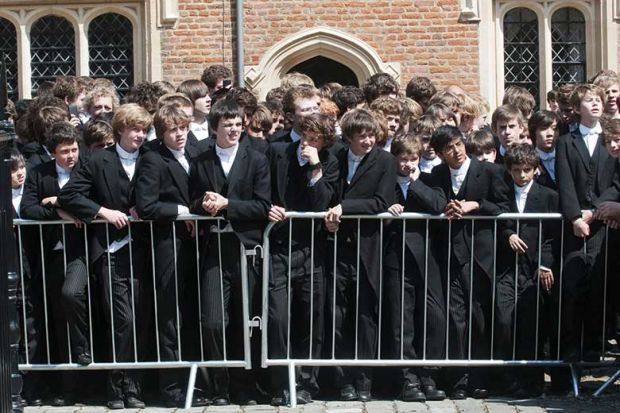The number of students from the most privileged backgrounds enrolling in higher education in England will have to shrink substantially if universities are to meet their targets for enrolling disadvantaged students without significant sector expansion, the Office for Students has said.
The regulator has said that it wants to eliminate the gap in entry rates between the most and the least advantaged backgrounds within the next 20 years, but it warns in a board paper that Department for Education forecasts “predict that there will be minimal growth in student numbers across the sector”.
If this is the case, the target could be met only by “considerably reducing” the proportion of students from the most affluent neighbourhoods who enrol, the paper says.
The participation rate for 18- to 30-year-olds from the most advantaged backgrounds now stands at 57 per cent, compared with 26 per cent among the most disadvantaged. For these numbers to converge at about 43 per cent in 2038, the participation rate for the most advantaged students would have to drop by 14 percentage points, the OfS says. At the same time, the participation rate for students from the least privileged backgrounds would have to rise by 16 percentage points.
The participation rate for the second most-advantaged group of students would also have to shrink, from 48 per cent to 44 per cent.
The OfS has delayed formalising its targets in this area pending the outcome of the government’s review of post-18 funding, which the regulator says “will have implications for the size and shape of the higher education sector”.
If the review leads to a reduction in tuition fees and a rise in direct public funding for universities – as has been suggested – the government might have to reintroduce a cap on student numbers and might not want to see major sector expansion.
An alternative scenario presented by the OfS, under which the participation of students from poorer backgrounds would gradually grow to match the enrolment rate of their more privileged peers, would require the sector to grow by about 50 per cent over 10-20 years, the OfS paper says.
This echoes a report released last year by the Higher Education Policy Institute that predicted that the government would have to find funding for 300,000 extra undergraduate places in England by 2030 if it was to meet likely future demand.
Chris Millward, the OfS’ director for fair access and participation, told Times Higher Education that he supported the growth of higher education because “the expansion over the last decade and beyond has enabled thousands of students to get the experience of higher education, which is wonderful and life-changing in itself”.
“However, what I’m looking for from universities is for them to become more equal than they are now, and I don't think that has happened substantially in the last decade. The [Higher Education and Research Act 2017] is very clear that it is the duty of the OfS to see that happen,” he said.
POSTSCRIPT:
Print headline: English universities may have to turn away elite to hit participation targets
Register to continue
Why register?
- Registration is free and only takes a moment
- Once registered, you can read 3 articles a month
- Sign up for our newsletter
Subscribe
Or subscribe for unlimited access to:
- Unlimited access to news, views, insights & reviews
- Digital editions
- Digital access to THE’s university and college rankings analysis
Already registered or a current subscriber? Login








